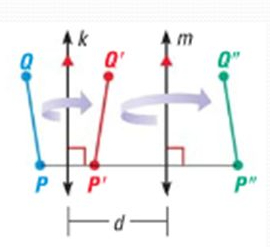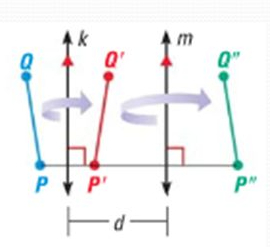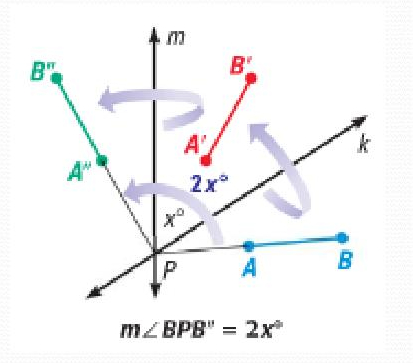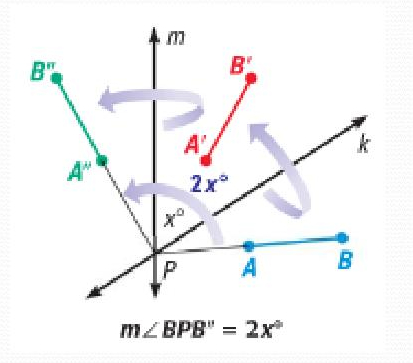Geometry Honors: 9.5 Perform Rotations to 9.7 Identify and Perform Dilations
1/24
There's no tags or description
Looks like no tags are added yet.
Name | Mastery | Learn | Test | Matching | Spaced |
|---|
No study sessions yet.
25 Terms
Rotation
a transformation in which a figure is turned about a fixed point, called the center of rotation
CW (rotation notation)
clockwise
CCW (rotation notation)
counter-clockwise
90° CCW about the origin
(x,y) → (-y,x)
180° CCW or CW about the origin
(x,y) → (-x,-y)
270° CCW about the origin
(x,y) → (y,-x)
What is 90° CCW about the origin the same as?
270° CW about the origin
What is 270° CCW about the origin the same as?
90° CW about the origin
When rotating a line, what is the same?
CW and CCW
What happens when a line is rotated 90° or 270°?
The resulting line is perpendicular to the original line.
What happens when a line is rotated 180°?
The line rotates back onto itself (no change, same equation).
Performing rotations about a non-origin center
- Graph pre-image and plot center of rotation
- Write vectors formed from the center of rotation to each vertex (in component form)
- use rotation rules about the origin to rotate the vectors
- apply the rotated vectors from the center of rotation to graph new points
Composition of transformations
when two or more transformations are combined to form a single transformation
Glide reflection
when there is a translation then a reflection

Reflection in Parallel Lines Theorem
If lines k and m are parallel then a reflection in line k followed by a reflection in line m is the same as a translation

Properties of Reflection in Parallel Lines Theorem
if p" is the image of p, then line pp" is perpendicular to both k and m
pp" = 2d where d = distance between k and m

Reflections in Intersecting Lines Theorem
If k and m intersect at point p then a reflection in line k followed by a reflection in line m is the same as a rotation about point p

Properties of Reflections in Intersecting Lines Theorem
the angle of rotation is (2x)° where x is the measure of the acute (or right) angle formed by k and m
Dilations
an enlargement or reduction of a figure with respect to a fixed point, called the center of dilation
Unlike translations, reflections, and rotations, what do dilations produce?
similar figures
Scale factor
k, that tells how much a figure is enlarged (k>1) or reduced (0<k<1)
Rule for dilation about the origin
P(x,y) → P'(kx,ky)
Performing dilations about a non-origin center
- Graph pre-image and center of dilation
- Write vectors from center of dilation to each vertex
- Apply scale factor to each vector, ⟨a,b⟩ → ⟨ka,kb⟩
- Use dilated vectors to plot the image, give coordinates of image
How to identify the center of dilation
draw lines through each pair of corresponding vertices, the center of dilation is the point of intersection
How to identify the scale factor
compare corresponding lengths OR compare corresponding vectors